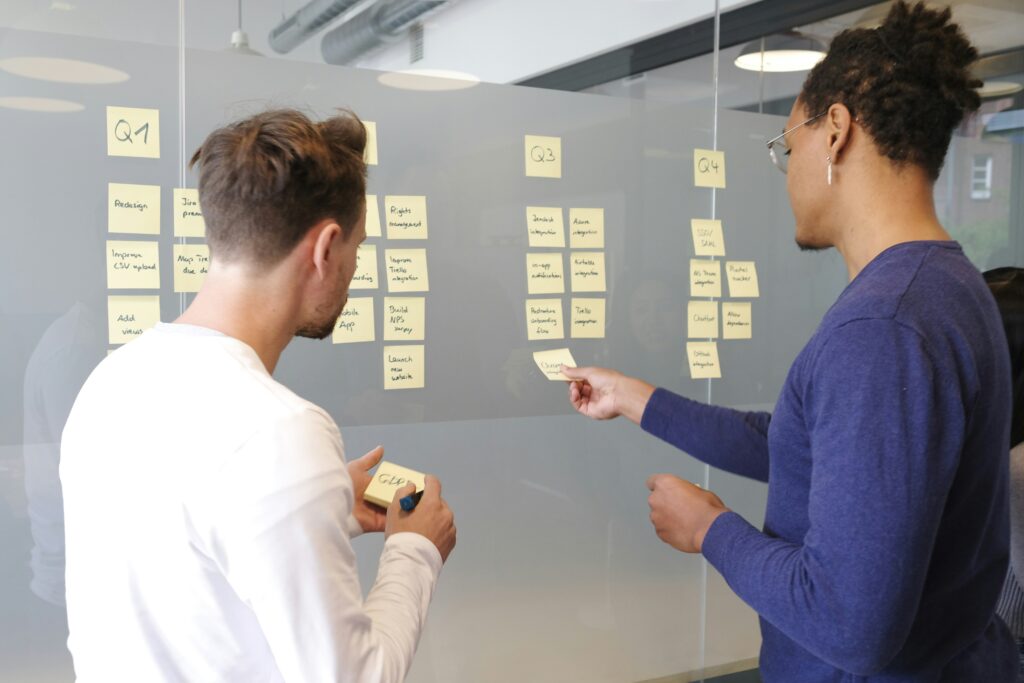Making a shift to product-led growth sounds pretty appealing, especially to product managers. Knowing your baby is the driving engine behind the entire company’s success puffs up our egos and makes our jobs seem more important than ever.
But unless your company offers paid services along with its line of products, how is this different from “regular” growth? And what does it mean for the product leaders steering the ship and plotting out roadmaps?
Wes Bush of the Product-Led Institute has literally written the book on product-led growth and joined ProductPlan co-founder Jim Semick on a recent webinar to discuss this and other related topics.
What is Product-Led Growth?
The traditional sales model for almost anything is a potential customer interacting with a salesperson. That salesperson may have proactively reached out to the prospect or they might have strolled into a showroom or called up the vendor themselves.
Regardless of who initiated the interaction, the model is one where the salesperson is driving the conversation. They’re assessing what the prospect is looking for, what problems they’re trying to solve, and the overall context of the potential purchase.
The salesperson is also doing a lot of education as they tout various features and functionality, reference other satisfied customers, and highlight the ease of use or simplicity of implementation and integration. Whether it’s a new car, ERP software, or a timeshare, they’re doing most of the talking.
Product
In a product-led model, it’s the potential buyer that is leading the charge. They’re actively seeking a solution, shopping around to explore their options, doing their own research, and ultimately experiencing the product before they ever plunk down their credit card or issue a purchase order.
In these cases, the product is essentially selling itself. Prospects try it out, see how it works, and eventually make their own decision whether to convert their trial to purchase or upgrade to a paid tier of service.
Growth
The “growth” part of product-led growth kicks in via the scalability of this model. It would take an army of salespeople to call on all these potential customers, walk them through the value proposition, and hold their hand while they try it out.
But when you’re trying to close dozens or hundreds of thousands of deals per week, the salesperson-driven model falls apart. It’s simply too expensive to grow at the desired rate and creates scenarios where the payback on the cost of acquisition is to create a sustainable, growing business. When the customers are doing most of the legwork themselves, growth happens organically and the product itself is its best spokesperson.
Why Product-led Growth is Having A Moment
“Whether it’s your cellphone, your Internet, everything in tech is deflationary. That means consumers want to pay less for your software tomorrow,” Bush said.
While this has always been the case with any new technology, the low barrier to entry in today’s marketplace has greatly accelerated the trend. That means it’s much cheaper to start new companies and attack both existing and emerging markets.
“It’s easier to start your business, but it’s harder to grow,” Bush added, referencing the fact that the cost of acquisition has increased 50% during the past five years.
Simultaneously, there’s been a distinct change in shopping behavior. “The buyer has changed. We prefer to self-educate,” Bush said, referencing research from Forrester indicating an overwhelming majority of buyers prefer to self-educate than talk to someone in sales.
Semick echoed this sentiment, citing ProductPlan’s own experience.
“We discovered really early on that they don’t want to have their handheld, especially by a human,” Semick said, citing the tendency of product managers to do their own research. “You can figure it out for yourself, the product speaks for you. You can discover new features in the product as you use the product.”
This dynamic dovetails especially well with SaaS companies that are able to offer free trials or adopt a freemium model. Letting customers “try before they buy” creates a much wider sales funnel, and the product itself is now an integral part of the buying experience.
Is Product-led Growth a Fit for Your Product?
It’s still early days for product-led growth, as only 16% of the webinar’s attendees had adopted it to date. And while product-led growth isn’t a perfect fit for every product, there’s a fairly quick way to assess its viability.
In a nutshell, you’re choosing between three options:
1. No touch
100% self-service as customers can research, evaluate/try the product, and make a purchase without any interaction with company staff.
2. Low touch
The sales team only reaches out after there are “product-qualified leads” that come in after a prospect has started using the product. Sales are answering questions and “closing,” but not “hunting.”
3. High touch
Traditional sales-led approach.
These models aren’t mutually exclusive, however, and there can be a mix within the same company, often based on the size of the potential opportunity. To evaluate whether or not to shift to product-led growth, Bush recommends using the four-step MOAT Framework.
Market Strategy:
The first step is defining your market strategy and how you’re trying to grow in your particular category:
Differentiated strategy
You’ve created a superior product for a specific market niche that stands apart from the current offerings. This allows you to charge a premium, but because it’s a more confusing and complex product you might need salespeople to educate prospects. For example, a real estate-specific CRM versus HubSpot.
Dominant player
Your product is better than the competition and you can charge less for it than other offerings. In these cases, a free trial or freemium model is the only way to keep acquisition costs low enough to serve all those customers. Think Netflix or Spotify.
Disruptive strategy
In this case, you’re offering a “worse” product but charging less. This doesn’t mean it’s a “bad” product, just one that doesn’t do as much as the competition because it’s aimed to serve a specific kind of need. This prevents customers from having to purchase a product that’s really overkilling for how they’ll use it, disrupting that product’s market dominance. In this case, it’s Canva for the casual user and Photoshop for the hardcore professional.
Ocean Condition:
The “O” in MOAT asks you to determine which kind of market you’re entering:
Blue Ocean
A new, uncontested market requiring lots of customer education, which necessitates sales reps to inform and cultivate.
Red Ocean
A vastly competitive, well-established space. Here, the product-led model is the only one that makes sense to achieve any market share or growth.
Audience.
Next, it’s time to determine who is being targeted during the sales process. Are you going after the buyers or the end-users? Is it a top-down sales approach or a bottom-up?
Product-led growth can only work when the company targets who will actually use the product.
Time-to-value.
Finally, you must assess how quickly a user will have that magical moment where the value all clicks. Product-led products require a quicker path to this realization.
For a complex B2B product, the time-to-value might take weeks or months. This can be overcome by mapping out the user journey and concentrating on how to start solving pain points faster to shorten that journey.
At the end of the day it all comes down to this, Bush said: “Does sales add value or is it adding friction?”
The Best Benefits of Product-Led Growth
There are many reasons to embrace product-led growth if your product passes the previous MOAT Framework test above:
- It is not the dominant growth engine in the SaaS economy
- The top of the sales funnel gets much wider
- It lowers customer acquisition costs
- The sales cycle speeds up, accelerating revenue
- Growth is compounded versus linear
- You can rapidly achieve growth on a global scale
- Higher revenue per employee
- Generates better user experiences
Any of those would be good reasons to take the leap, but Bush particularly emphasized the importance of compound growth. In a traditional sales model, each salesperson can only have a relationship with so many prospects, which means you must hire more and more salespeople to achieve any kind of exponential growth.
However, in a product-led growth model, there’s no relationship between the number of salespeople and the number of closed deals. Growth comes by improving the product experience so more trials convert and by removing friction from the self-service sales process. Each incremental tweak and enhancement gets compounded month over month.
Show Versus Tell
When done well, product-led growth comes down to the communication and execution of the value proposition. This has worked well for ProductPlan, where the product itself is experiencing organic growth within existing customer organizations.
Semick said the increased share of wallet thanks to offering free viewer licenses. This exposes other parts of the business to ProductPlan’s roadmaps and planning boards before they even use the product themselves.
“All of this is occurring without humans,” Semick said. “All of this is occurring because they’re having a great product experience.”
Bush recommends the UCD model for successful product-led growth:
- Understand your value
- Communicate it to the market
- Deliver it
This multifaceted process views the product experience along three axes:
1. Functional
With this product, the user can do something specific
2. Emotional
Using this product makes them feel a particular, positive way
3. Social
Using this product (or completing the tasks this product facilitates) positively influences how the user is perceived by others.
Onramps to Shift to Product-led Growth
Not every organization has the opportunity to begin with a clean slate, but even existing products can pursue this approach. Bush highlighted new product launches and product line extensions as the prime candidates to start this journey, rather than converting an existing product to this model.
He recommends trying out both freemium and free trial models and then following one with the other SaaS pricing model. In practice, this would be either offering a limited version of the product with the opportunity to try out the fully-featured paid version for a limited time or starting with that free trial and then downgrading users to the limited free version after an initial period of time.
Both of these approaches give users a free taste of what a paid experience would look like while retaining those customers for the long term, even if they’re not paying for anything right now. This provides further opportunity to convert them to paying customers down the line, perhaps as new features and functionality are introduced that they’d be willing to pay for.
To learn more about how to shift to product-led growth and whether it’s the right fit for your company, watch the entire webinar for free or tune into the ProductLed Institute’s podcast episode featuring Jim Semick.







